Northern Long-Eared Bat Mist Netting and Radio Telemetry Study
Tracking a federally listed bat species across New Jersey
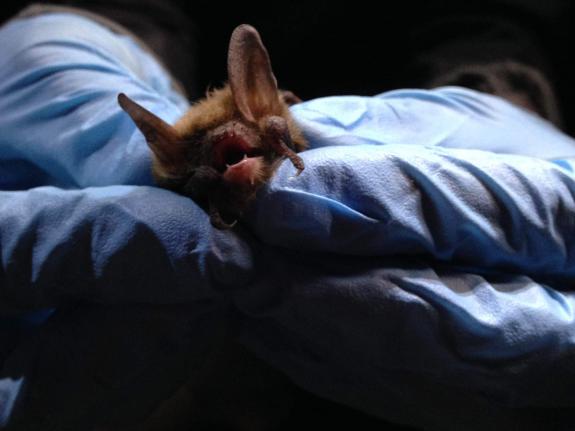 Female Northern long-eared bat (c) Ethan Gilardi
Female Northern long-eared bat (c) Ethan Gilardi
Northern long-eared bats
The Northern long-eared bat, also known as Northern myotis (M. septentrionalis) is one of four New Jersey bat species belonging to the Myotis genus. It is similar in size and appearance to the little brown bat (M. lucifugus) and Indiana bat (M. sodalis), with an average weight of six to nine grams, a body length of around three inches, and a nine to ten inch wingspan.
The Northern long-eared bat is one of the species that has been most affected by White-nose Syndrome (WNS), suffering an overwhelming 98% reduction in numbers in WNS-affected areas. As a result, the U.S. Fish and Wildlife Service listed the Northern long-eared bat as Threatened under the Endangered Species Act in April 2015.
Mist netting & Radio Telemetry Project
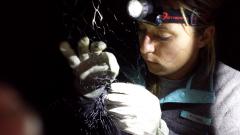 Zoom+ Stephanie Feigin carefully removes big brown bat from mist net (c) MacKenzie Hall
Zoom+ Stephanie Feigin carefully removes big brown bat from mist net (c) MacKenzie Hall
Each summer, the Conserve Wildlife Foundation of New Jersey partners with New Jersey Division of Fish and Wildlife Endangered and Nongame Species program to conduct a statewide mist-netting and radio telemetry study to learn more about the summer distribution and habitat selection of Northern long-eared bats. This is an important project that can shed light on a species we know all too little about, and can help guide our decisions through a better understanding of the bats’ forest habitat requirements and roost locations.
This project focuses on locations across the state to generate a big-picture understanding of diverse habitats and regions.
Mist Netting
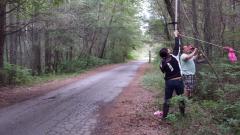 Zoom+ The team setting up a mist net in Brendan Byrne State Forest (c)MacKenzie Hall
Zoom+ The team setting up a mist net in Brendan Byrne State Forest (c)MacKenzie Hall
Mist nets are extremely fine nylon or polyester mesh nets that are strung between two poles. The nets can be purchased in a variety of lengths to accommodate different survey locations. At each location, we chose two different sites to deploy our five mist nets (each site with a different arrangement of nets) for eight hours at each site in places we suspect are good travel corridors for Northern long-eared bats. We conduct netting nights at each site throughout the months of June, July, and the first few weeks of August.
Northern long-eared bats are the target species for this project, however any bat in the myotis genus is of interest. Once a bat is caught in the net, the bat is safely taken out of the net and processed.
The team collects data on:
- Forearm measurements
- Weight
- Age (juvenile or adult)
- Sex
- Reproductive status
- Wing damage index
After these data points are collected, a uniquely numbered metal band is placed on the forearm of the bat.
Radio Telemetry
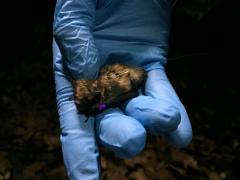 Zoom+ Female Northern long-eared bat with transmitter attached to her back. (c) Stephanie Feigin
Zoom+ Female Northern long-eared bat with transmitter attached to her back. (c) Stephanie Feigin
If a bat of interest is caught, a specialized radio transmitter (LB- 2 model by Holohil Systems Ltd.) is immediately attached after an examination. Radio transmitters are placed in between the shoulders of the bat with surgical cement. Tracking occurs the next day after the transmitter is attached and continued until the transmitter falls off. The maximum distance the antenna can receive a signal from the transmitter is ¾ of a mile in perfect (unobstructed) conditions. Bats are tracked to their diurnal roosts and all pertinent data about roost site and surrounding area is recorded. Evening emergence counts are conducted at each identified roost tree.
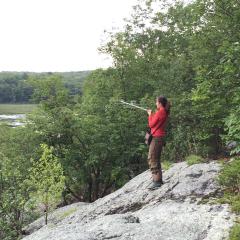 Zoom+ Amanda Bevan, Rutgers University graduate student, scans area with ATS scanning receiver and Yagi 3-element antenna for a signal from the transmitter (c) Stephanie Feigin
Zoom+ Amanda Bevan, Rutgers University graduate student, scans area with ATS scanning receiver and Yagi 3-element antenna for a signal from the transmitter (c) Stephanie Feigin
The goal of this project is to better understand the Northern long-eared population, distribution and habitat use throughout New Jersey. Understanding these factors will lead to better forest management practices and can help guide conservation decisions through. Ultimately, these data can be utilized in forest stewardship plans for New Jersey forest managers and landowners, allowing us to better protect the remaining populations in New Jersey.
Project Report:
2017 Bat Mist Netting & Radio Telemetry Report - 10.7MB |
This work was made possible with the support from the Franklin Parker Conservation Grants, EarthColor, and the Conserve Wildlife Matching Grant Program. Thank you to our supporters!
Learn More:
- Tracking A Federally Listed Bat Species Across New Jersey
- Help Northern Long-Eared Bats Become Listed As Endangered Species
- Northern long-eared bat in online field guide
Check it out!:






